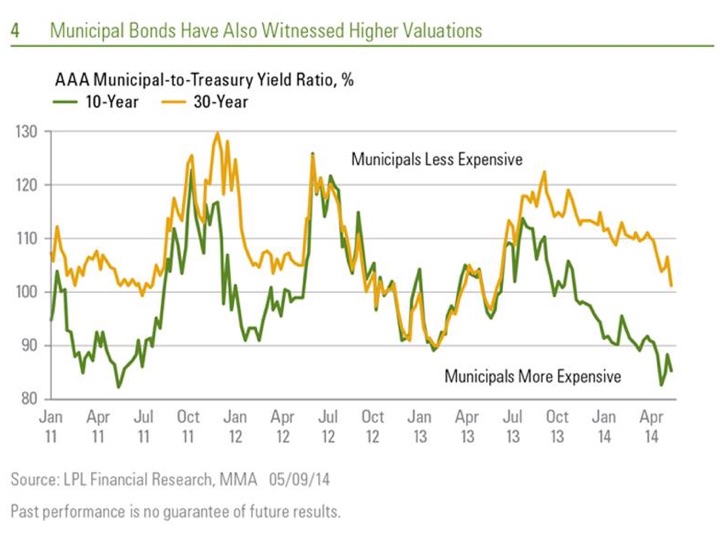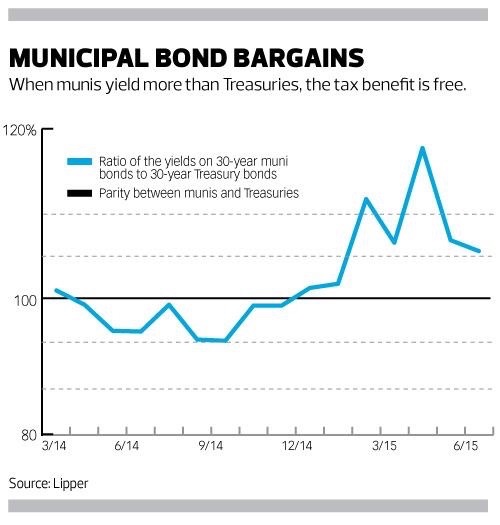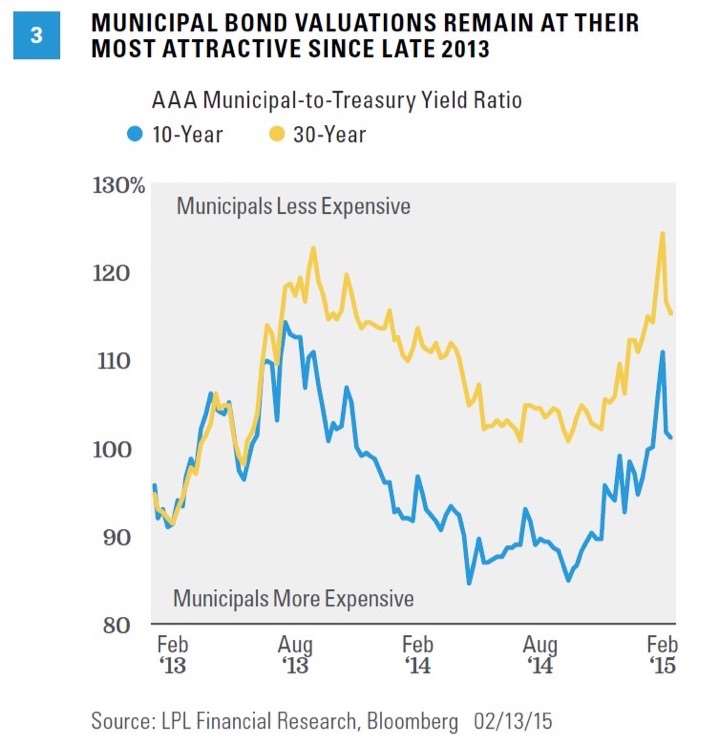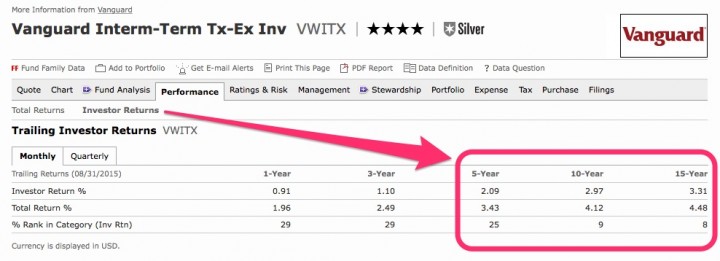I’ve been investing in tax-exempt municipal bonds for a few years now. I made the change due to a combination of reasons. For one thing, I started running out of room in my tax-deferred accounts for US Treasury bonds, TIPS bonds, and REITs. Second, I believe that buying muni bonds through a Vanguard actively-managed mutual fund gives me a diversified mix of high-quality bonds. Third, the effective after-tax yields on muni bonds can be very attractive when compared to US Treasury bond yields. In many time periods, muni yields have been as high as Treasury yields, even before any tax considerations. This was very rare pre-2008 financial crisis, with the historical average being a 80% ratio.
Here are a few charts that track the relationship between the yields on US Treasury and Investment-grade municipal bonds. Notice that the ratio of Muni-to-Treasury has kept close to 100% in the last few years. I’ve tried to dig up enough to cover a continuous timeline, but let me know if you have a better graph.

Source: Wealthmanagement.com

Source: Financial-Planning.com

Source: ValueWalk.com
Although it can be tempting to use these charts as timing tools, I try to focus on the overall picture. Due to the tax-exempt advantage, I am happy as long as the muni rates are roughly the same as Treasury rates.
As of September 9, 2015, the SEC yield of Vanguard Intermediate-Term Tax-Exempt Investors Shares (VWITX) was 1.78% while the SEC yield of Vanguard Intermediate-Term Treasury Investor Shares (VFITX) was 1.43%. Both are hardly exciting and the muni fund is considered a little more risky (how much riskier is quite difficult to quantify), but for my own portfolio I think the higher yield is worth it especially considering the muni interest is exempt from federal income taxes.
Muni bonds are a somewhat different from other asset classes because they are owned mostly by individuals as opposed to institutions. Based on Morningstar investor returns, us individuals haven’t shown any superior skill at market timing their buys.
However, the performance gap is similar to that of the Vanguard Treasury fund of similar duration. So perhaps that gap is just due to the effect of natural cashflow timing (i.e. regular investments over time) rather than failed attempts at chasing performance.

 The Best Credit Card Bonus Offers – 2025
The Best Credit Card Bonus Offers – 2025 Big List of Free Stocks from Brokerage Apps
Big List of Free Stocks from Brokerage Apps Best Interest Rates on Cash - 2025
Best Interest Rates on Cash - 2025 Free Credit Scores x 3 + Free Credit Monitoring
Free Credit Scores x 3 + Free Credit Monitoring Best No Fee 0% APR Balance Transfer Offers
Best No Fee 0% APR Balance Transfer Offers Little-Known Cellular Data Plans That Can Save Big Money
Little-Known Cellular Data Plans That Can Save Big Money How To Haggle Your Cable or Direct TV Bill
How To Haggle Your Cable or Direct TV Bill Big List of Free Consumer Data Reports (Credit, Rent, Work)
Big List of Free Consumer Data Reports (Credit, Rent, Work)
With the low yields is it still advisable to use limited tax deferred space for bonds?
The US Treasury can not go bankrupt [in theory] as it can always just print more money to pay obligations. The same can not be said of city, county and state governments. During financial turmoil, the Treasury market will rally from the ‘flight to safety’ whereas the Muni market may get slammed as investors perceive the issuers’ inability to continue to pay obligations. Just something to consider; the safety of these bonds is not the same as Treasuries.
Does Vanguard have state-specific muni bond funds so you could own bonds from your own state?
Vanguard has state-specific TE funds for California, Massachusetts, New Jersey, New York, Ohio, and Pennsylvania
I have been dollar cost averaging into municipal bond funds since 2002. Built up a good six figure sum. Recently moved to California from Arizona. The fund family has California municipal bond funds so I am looking at them. But I notice Vanguard has California municipal bond funds and I can easily drop my expense ratio by going to Vanguard. I am leery about buying California debt, bough the bond ratings are about the same as Arizona’s.